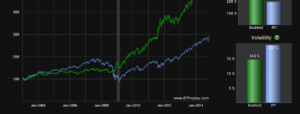According to Moody’s a distressed exchange occurs when a distressed company offers “creditors new or restructured debt, or a new package of securities, cash or assets, that amounts to a diminished financial obligation relative to the original obligation.”
Since the financial crisis, the number of these distressed exchanges has ballooned as companies try to work around a traditional bankruptcy. Deals peaked in 2015, when many oil & gas companies, reeling from crashing oil prices, found themselves struggling to keep the lights on.
As Bloomberg reported at the end of 2015, distressed-exchange transactions accounted for 44% of US non-financial defaults during 2015, a similar proportion as in the direct aftermath of the 2008 financial crisis.
Distressed Exchanges Becoming More Common
Debt exchanges are becoming more common than they were in 2008, thanks to weaker investor protections that are hallmarks of the post-crisis era. In the two decades leading up to 2007, on average 10% of deals every year qualified as distressed exchanges.

Research from Moody’s shows that distressed exchanges generally work out better for creditors with a higher recovery rate than more traditional forms of restructuring. A recent report from the credit agency shows that the recovery rate averages 70% for senior unsecured bonds in a distressed exchange compared with 40% in a bankruptcy default.
This does not mean that credits escaped unscathed. Moody’s analysts look at 322 distressed exchanges and found that 87% of the distressed exchanges led to a principal haircut and 40% “resulted in maturity extension for near-term debts, deferral of principal or interest payments, or amendments to payment terms that either converted interest payments from cash to payment-in-kind, reduced coupon rates or both.” Of the 322 cases in the sample, 29% were debt-for-debt exchanges, 27% were cash repurchases, 16% were debt-for-equity swaps, and the remaining 28% were some combination of cash, new debt or equity.













Leave A Comment